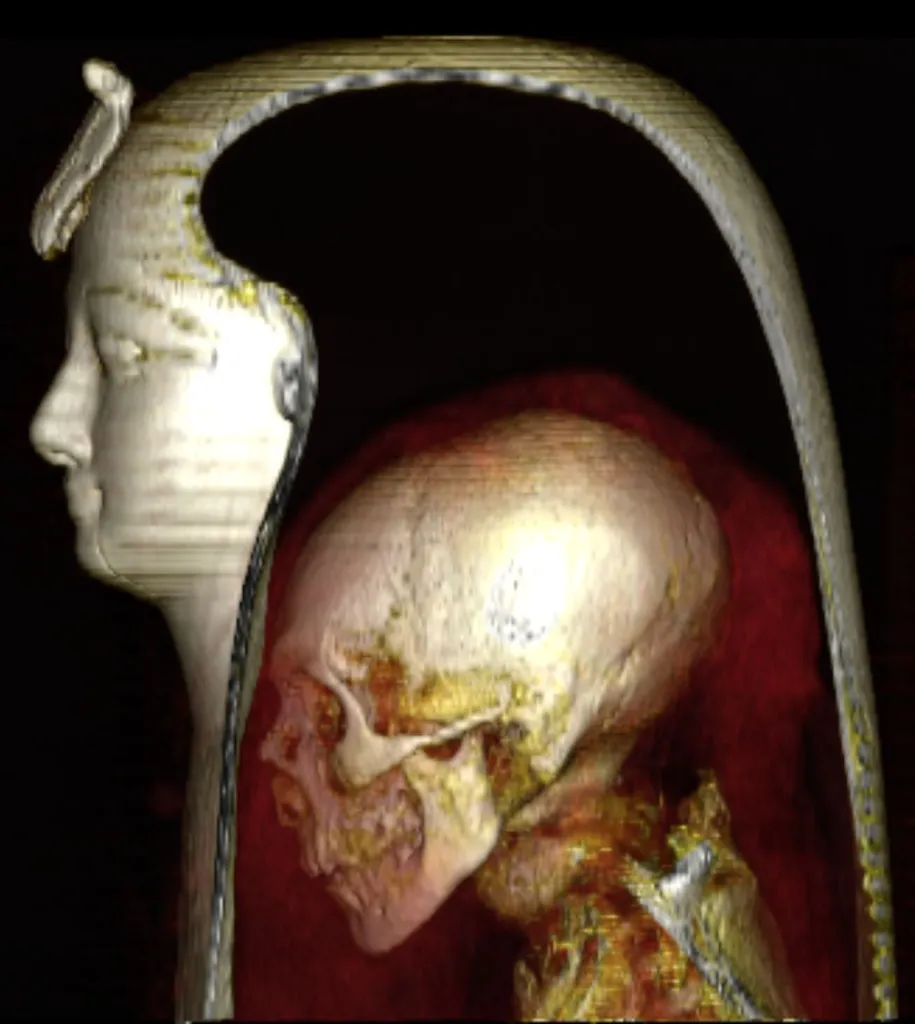
All royal mummies discovered in the nineteenth and twentieth centuries have been opened for research. Except for one: Egyptologists have never dared to open the mummy of Pharaoh Amenhotep I,
because it is impeccably wrapped, festooned with lovely flower garlands, and adorned with an exquisite lifelike mask set with vibrant stones. However, for the first time, Egyptian scientists have employed three-dimensional CT (computed tomography) scanning to ‘digitally unwrap’ and analyse the contents of this royal mummy. They published their findings in the journal Frontiers in Medicine.
The first time Amenhotep’s mummy was ‘opened’ was in the 11th century BCE, more than four centuries after he was mummified and buried. Hieroglyphics tell how priests renovated and reburied royal mummies from more distant dynasties during that time period to remedy the harm caused by tomb robbers.
“The fact that Amenhotep I’s mummy had never been unwrapped in modern times provided us with the opportunity to study not only how he was mummified and buried originally, but also how he was treated and reburied twice by High Priests of Amun centuries after his death,” said Dr. Sahar Saleem, lead author of the study and professor of radiology at Cairo University’s Faculty of Medicine.
Will you offer us a hand? Every gift, regardless of size, fuels our future.
Your critical contribution enables us to maintain our independence from shareholders or wealthy owners, allowing us to keep up reporting without bias. It means we can continue to make Jewish Business News available to everyone.
You can support us for as little as $1 via PayPal at office@jewishbusinessnews.com.
Thank you.
Natural causes of death
“By digitally unwrapping the mummy and ‘peeling away’ its virtual layers – the facemask, the bandages, and the mummy itself – we were able to analyze this exceptionally well-preserved pharaoh in unprecedented detail,” Saleem explained.
“We demonstrate that Amenhotep I was roughly 35 years old at the time of his death. He stood roughly 169cm tall, was circumcised, and had healthy teeth. He wore 30 amulets and a one-of-a-kind golden belt with gold beads beneath his wrappings.”
“Amenhotep I appears to have inherited his father’s physical characteristics, including a narrow chin, a small narrow nose, curly hair, and slightly protruding upper teeth.”

“We found no scars or deformities caused by sickness to support the cause of death, except for many post mortem mutilations, presumably by tomb robbers following his initial burial,” Saleem added. His entrails had been removed, but not his brain or heart, by the first mummifies.”
Amenhotep I’s mummy (whose name translates as ‘Amun is satisfied’) was unearthed in 1881 at the archeological site Deir el Bahari in southern Egypt, alongside other reburied royal mummies.
Amenhotep governed Egypt’s 18th dynasty from roughly 1525 to 1504 BCE (after his father Ahmose I, who had expelled the invading Hyksos and unified Egypt).
Egypt was affluent and secure throughout his reign, and the pharaoh embarked on a religious building frenzy and conducted victorious military operations to Libya and northern Sudan.
He and his mother Ahmose-Nefertari were worshiped as gods upon his death.
Reburial in antiquity
Saleem and the Egyptologist Dr. Zahi Hawass had suggested that the primary goal of 11th-century restorers was to repurpose royal burial goods for subsequent pharaohs. However, they contradict their own theory in this instance.
“We demonstrate that at the very least for Amenhotep I, the priests of the twenty-first dynasty painstakingly repaired the injuries caused by tomb thieves restored his body to its former grandeur, and preserved the fine jewels and amulets in situ,” Saleem explained.
Hawass and Saleem examined around 40 royal mummies from the New Kingdom as part of the Egyptian Antiquity Ministry’s 2005-launched Egyptian Antiquity Ministry Project.
“We demonstrate that CT imaging may be employed profitably in anthropological and archeological investigations of mummies from various civilizations, such as Peru,” Saleem and Hawass concluded.



